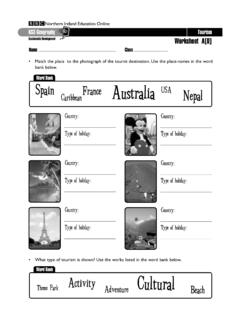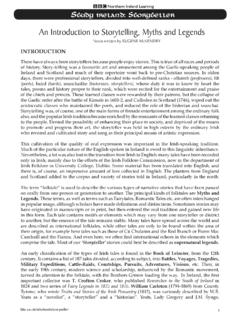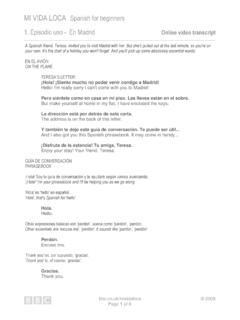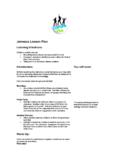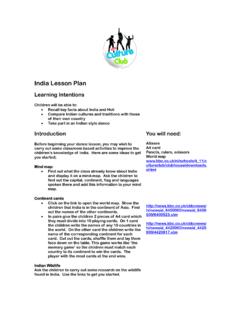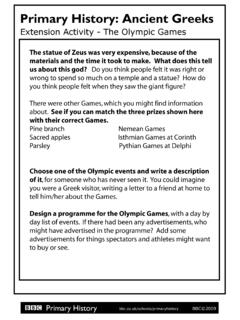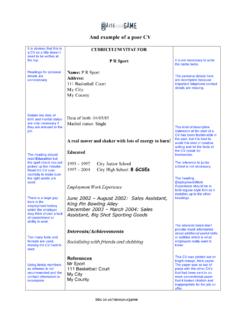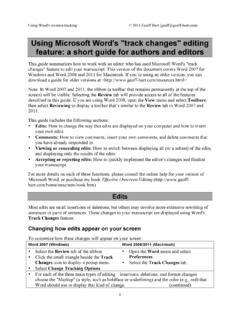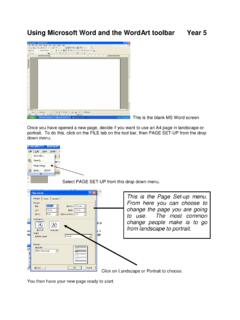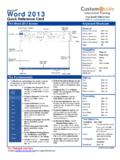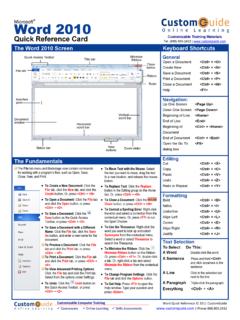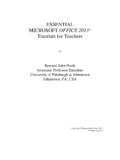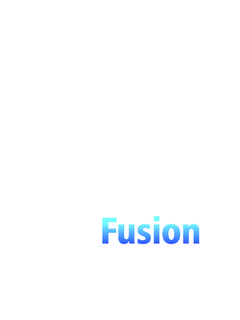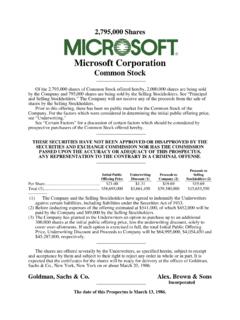Transcription of Guide to the essentials of creating accessible PDFs with ...
1 Guide to the essentials of creating accessible PDFs with microsoft Word and Acrobat Professional 8 1 Contents Introduction ..3 Required software ..3 What makes a PDF accessible ? ..3 Part 1: working in microsoft Styles and Formatting ..4 Table of Contents ..4 Text formatting ..4 Alt text ..4 Colour contrast ..4 Footnotes ..5 White Links ..6 Converting from Word to a tagged Part 2: working in Acrobat Professional Checking for accessibility problems ..7 Tools available in Acrobat Professional ..8 The TouchUp Reading Order Tool ..8 The Order Panel ..8 The Tags Methods for repairing common problems ..10 Checking for the presence of Table of Contents ..10 Links ..11 Correcting the reading order Language settings ..12 Adding Alt text to content-bearing Removing non-content-bearing images and headers and footers ..12 File size Security settings ..13 Screen reader Quick reference of recommended tools and commands.
2 14 2 Introduction This is a quick Guide to the essentials of creating accessible PDFs for publication on the web. It focuses on text and image based documents created with microsoft Word. It does not include topics such as PDF forms, multimedia, etc. More details on these topics and on all PDF accessibility issues can be found in Adobe s Create accessible PDF Documents with Adobe Acrobat (pdf ) This Guide is divided into two parts. The first is aimed at content creators working in microsoft Word. It outlines techniques for creating Word documents that will convert well into accessible PDFs. The second part covers the tools and techniques needed to fix any problems that may arise during conversion from Word to PDF, or for repairing PDFs that have not been authored using the techniques described in part one. Required software Part one requires only access to microsoft Word.
3 Part two requires Adobe Acrobat Professional 8. In addition, access to, and a working knowledge of a screen reader such as JAWS would be helpful but is not essential . What makes a PDF accessible ? PDFs must be properly tagged. Tags are usually generated during conversion from Word to PDF. The reading order of the content must be clear, logical and easy to follow (including, for example, the position of footnotes). Images that convey useful information (as opposed to purely decorative images) must have text alternatives (or Alt text ). Decorative images and repeated headers and footers should be removed from the reading order so that screen readers and other assistive technologies ignore them. The document should include correctly formatted structural elements such as headings, a table of contents, links and bookmarks. Text should be formatted in such a way that it will be readable by people with vision impairments or cognitive disabilities (including dyslexia).
4 The natural language of the document must be specified. There must be sufficient contrast between foreground and background colours. The document s security settings (if any) must not exclude users of assistive technologies. 3 Part 1: working in microsoft Word Styles and Formatting Always use structural formatting for headings, body text, bulleted lists, numbered lists etc. These are applied using the Styles and Formatting panel (Format Styles and Formatting). It is important to note that text simply set in bold, for example, is not a heading. Such formatting is purely presentational and not structural. Structural elements, which are vital for accessibility, can only be added via the Styles and Formatting panel. Table of Contents Nearly all users will benefit from a properly formatted Table of Contents (TOC) providing active links to the various sections of a document.
5 It is particularly important in large documents to include a TOC. To do so, select Insert Reference Index and Tables. Select the Table of Contents tab. Click OK to create a TOC, based on the document s heading structure. Text formatting Never justify text. Always left-align when working in languages that are read left to right. Avoid using blocks of italicised text. Do not underline text that is not a link. Avoid double spaces between sentences. Alt text Always add Alt text to describe content-bearing (as opposed to purely decorative) images. To do so, click the image to select it, right-click and select Format Picture. Select the Web tab and type or pastethe required text (see figure). Important: for scanned documents, charts and graphs etc, it is essential to provide a comprehensive text alternative that fully conveys all of the information contained within or conveyed by the image.
6 Colour contrast Use sufficiently contrasting foreground and background colours and never rely on colour alone to convey information or meaning. Non-technical document producers may find the following tool useful for understanding colour contrasts as perceived by those with different forms of colour blindness: Those with an understanding of hexadecimal colour codes may also find the following useful Note: if you create a text box in Word (for example for a pull-out quote) do not give it a background colour. It is common for people with vision 4 impairments to change the colour scheme of a PDF for higher contrast. However, although PDF readers are able to change the foreground colour of text, they are unable to change the background colour. This can lead to some poor foreground/background colour combinations. Footnotes Footnotes should be used sparingly, if at all. As a general rule, effective web copy is short, snappy and to the point; footnotes are the opposite they provide fine detail.
7 Also, repairing PDFs so that footnotes appear in the right place in the reading order is essential for the content to make sense to a screen reader user. However, it is very time consuming to do. Lastly, be aware of the rapid growth in demand for access to web content via mobile phones. Footnotes work even less well on mobile phone screens than they do on PCs, for obvious reasons. They should be used with caution outside the environment for which they were designed: the printed page. Columns Select Format Columns to lay out text in columns. Never use tables to simulate multicolumn text. Tables Tables should be used only for the purpose of setting out tabular data and not for general page layout. They should always have meaningful column headings. If you do use them: Avoid tables that break across pages. If you cannot, then ensure that column headings repeat at the top of each page select Table Table Properties and under the Rows tab check Repeat As HRow At The Top Of Each Page.
8 Eader Never allow rows to break across pages. To prevent them from doing so, select Table Table Properties, and under the Rowstab, uncheck Allow Row To BreakAcross Pages option for that row (see figure). Avoid using complex tables. with s. ke of Complex tables include thosemore than one level of headingThese are very difficult to maaccessible. Consider breaking complex tables into a number smaller tables. White space To create a new paragraph, press the Return key once and once only. Do not use the Return key to add extra space between paragraphs or 5 to otherwise position copy on a page. Instead, use the "Spacing Before" and "Spacing After" paragraph properties, defined in the Styles and Formatting panel. Examples in this document are: the heading on the title page which uses Spacing Before of 198pt; and the space between paragraphs which is set with Space After of 6pt on Body Text.
9 Similarly, the Tab key or the space bar should never be used to position copy on a page. Doing so is liable to render your copy as gobbledygook when read with a screen reader or when converted to plain text format. Links Include live hyperlinks in the original document. These will convert well into live links in the finished PDF and are useful navigational aids. Converting from Word to a tagged PDF Tagging is at the heart of PDF accessibility. During the conversion process from Word to PDF, Acrobat will add a tag tree to the PDF that reflects the structure of the source document (see example on page 9). It is this structure that allows screen reader users and others to navigate the document. Incidentally, it also enables search engines to index the document properly. To convert a document to a tagged PDF, select Adobe PDF Convert to PDF or select the Convert to PDF button on the toolbar (in Word).
10 Generating the tag tree during the conversion of the document to PDF, rather than afterwards, almost always produces the best results. Do not print the document to PDF using Adobe PDF Printer as this produces an untagged document. A possible exception is when you know you are dealing with a corrupted source document which Acrobat might struggle to tag properly. In such a case tagging after conversion may be the better (or only) option. Conversion settings Before generating a tagged PDF for the first time, in Word, select Adobe PDF Change Conversion Settings. Select the Settings tab and ensure that the following check boxes are checked: Add Bookmarks to Adobe PDF. Add Links to Adobe PDF. Enable Accessibility and Reflow With Tagged PDF. Once set, these settings will persist. 6 Part 2: working in Acrobat Professional 8 The amount of editing a document will require after conversion to PDF will depend to a large extent on how closely the techniques outlined above have been followed in its creation.

